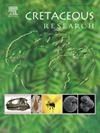Classostrobus doylei,葡萄牙西部 Figueira da Foz Formation(下古生代 - 上阿尔比统)出土的一种带有原位花粉的新栉水母圆锥体
IF 1.9
3区 地球科学
Q1 GEOLOGY
引用次数: 0
摘要
Classostrobus属的建立是为了容纳未附着的含Classopollis的球果。值得注意的是,Classopollis 作为一个整体在形态结构上表现出显著的差异,而且带有 Classopollis 花粉粒的雄球果比螯针叶树的无性器官更为罕见。本报告首次描述了一种新的螯合鳞茎微孢子锥--Classostrobus doylei,它含有Classopollis triangulus花粉粒,该标本来自葡萄牙西部埃斯特雷马杜拉地区(葡萄牙西部卢西坦盆地)Juncal小村附近的Carregueira露天粘土矿坑群中出露的沉积岩。来自 Carregueira 的含植物的地层属于 Figueira da Foz Formation 的 Famalicão 成员的基底部分,被认为是始新世晚期-阿尔卑斯早期。新发现的微孢子囊锥体较小,长约 2.0 毫米,宽约 1.5 毫米,呈卵圆形,具有典型的针叶结构,可能属于 Pseudofrenelopsis zlatkoi。雄球果由约 16 个盾状、交错的小孢子叶组成,呈正三角形。每个孢子叶由柄和正三角形头状花序组成,背面有 4-5 个卵圆形花粉囊。孢子叶的边缘部分长有单细胞毛状体。观察到的原位花粉粒轮廓呈三角形至近圆形,直径为 16-28 μm,有赤道束带、近赤道瓣膜、下端三裂痕和远端隐孔。花粉的超微结构是 Classopollis 的典型特征,只是外皮被破坏了。所研究的原位花粉粒与已知散布的三角花粉块(Classopollis triangulus)的数据一致。本文章由计算机程序翻译,如有差异,请以英文原文为准。
Classostrobus doylei, a new cheirolepidiaceous cone with in situ pollen from the Figueira da Foz Formation (lower Aptian – upper Albian), western Portugal
The genus Classostrobus was established to accommodate unattached Classopollis-containing cones. It is noteworthy that Classopollis as a whole shows significant variation in morphological structure, and male cones bearing Classopollis pollen grains are rarer than vegetative organs of cheirolepidiaceous conifers. A new cheirolepidiaceous microsporangiate cone, Classostrobus doylei, containing Classopollis triangulus pollen grains is described for the first time based on a single specimen from sedimentary rocks exposed in the Carregueira open-cast clay pit complex close to the small village of Juncal, in the Estremadura region(Lusitanian Basin, western Portugal). The plant-bearing horizon from Carregueira is included in the basal part of the Famalicão Member of the Figueira da Foz Formation, considered to be of late Aptian – early Albian age. The new microsporangiate cone is small, about 2.0 mm long and 1.5 mm wide, ovoid in shape and of typically coniferous structure, probably belonging to Pseudofrenelopsis zlatkoi. The male cone consists of about 16 peltate, imbricated microsporophylls of deltoid shape. Each sporophyll is composed of a stalk and deltoid head showing abaxially 4–5 ovoid pollen sacs. The marginal parts of the sporophylls display long and unicellular trichomes. The observed in situ pollen grains are triangular to subcircular in outline, 16–28 μm in diameter, with an equatorial girdle, subequatorial rimula, proximal trilete scar and a distal cryptopore. The pollen ultrastructure is typical for Classopollis, except for the destroyed condition of the exine. The in situ pollen grains under study are consistent with the data on known dispersed Classopollis triangulus.
求助全文
通过发布文献求助,成功后即可免费获取论文全文。
去求助
来源期刊

Cretaceous Research
地学-地质学
CiteScore
4.10
自引率
19.00%
发文量
235
审稿时长
12 weeks
期刊介绍:
Cretaceous Research provides a forum for the rapid publication of research on all aspects of the Cretaceous Period, including its boundaries with the Jurassic and Palaeogene. Authoritative papers reporting detailed investigations of Cretaceous stratigraphy and palaeontology, studies of regional geology, and reviews of recently published books are complemented by short communications of significant new findings.
Papers submitted to Cretaceous Research should place the research in a broad context, with emphasis placed towards our better understanding of the Cretaceous, that are therefore of interest to the diverse, international readership of the journal. Full length papers that focus solely on a local theme or area will not be accepted for publication; authors of short communications are encouraged to discuss how their findings are of relevance to the Cretaceous on a broad scale.
Research Areas include:
• Regional geology
• Stratigraphy and palaeontology
• Palaeobiology
• Palaeobiogeography
• Palaeoceanography
• Palaeoclimatology
• Evolutionary Palaeoecology
• Geochronology
• Global events.
 求助内容:
求助内容: 应助结果提醒方式:
应助结果提醒方式:


